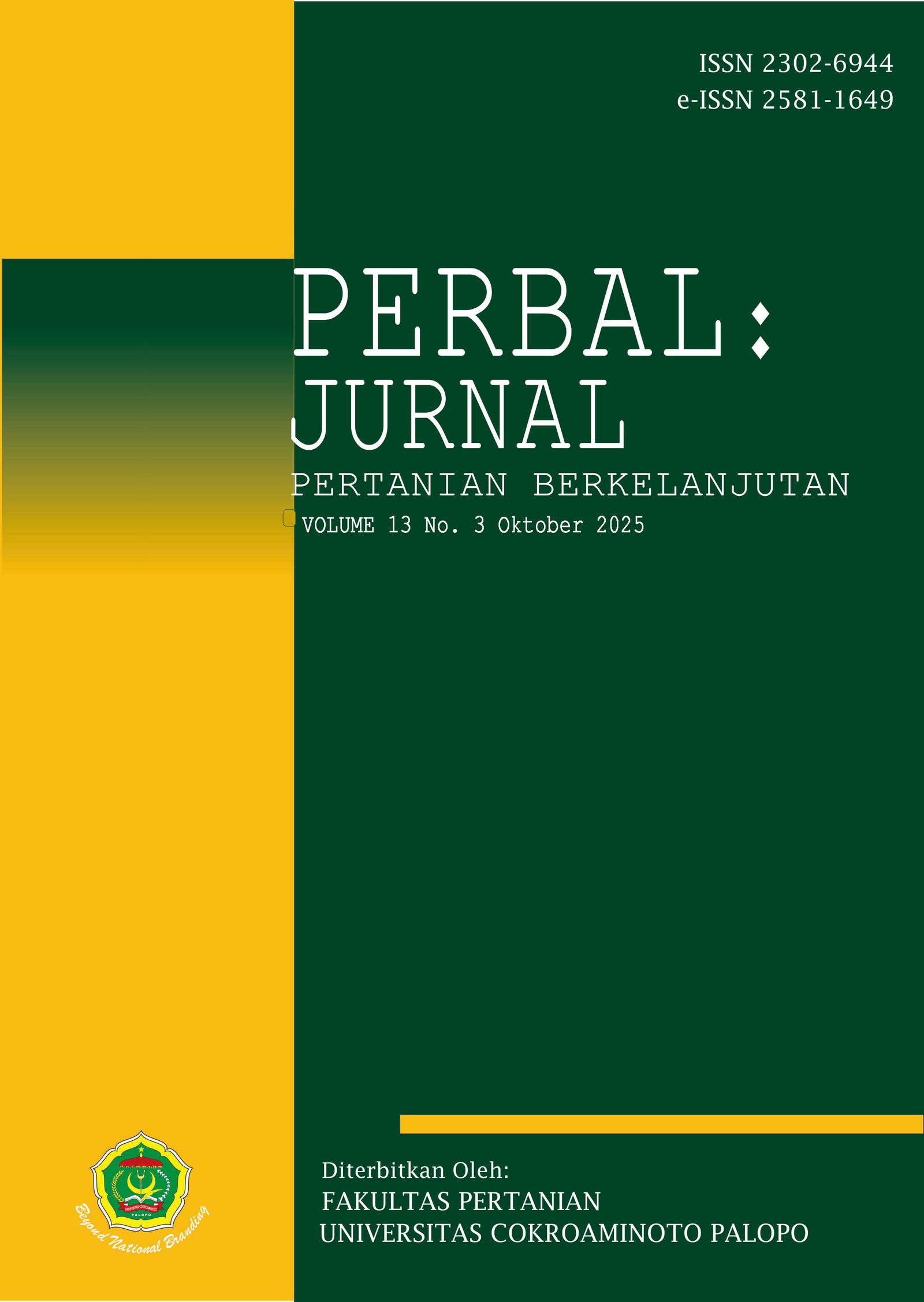Seleksi dan Aksi Gen Karakter Morfologi Kecambah Padi Varietas Inpari Nutri Zinc Berdasarkan Analisis Korelasi dan Sidik Lintas
Morphological Character Selection of Rice Sprouts Inpari Nutri Zinc Varieties Based on Correlation Analysis and Cross
DOI:
https://doi.org/10.30605/perbal.v13i3.7104Keywords:
Aksi gen, faktorial, keeratan hubungan karakter, pengaruh langsung, pengaruh tidak langsungAbstract
Analisis korelasi dan sidik lintas merupakan analisis statistik deskriptif untuk memahami hubungan langsung dan tidak langsung antar karakter morfologi. Penelitian ini bertujuan untuk mengetahui respon perendaman benih terhadap karakter amatan; menduga aksi gen yang mengendalikan karakter perkecambahan benih padi terhadap perendaman benih; memperoleh karakter amatan yang memiliki keeratan hubungan dengan karakter lainnya melalui nilai korelasi; dan mengetahui pengaruh langsung dan tidak langsung beberapa karakter amatan perkecambahan benih padi terhadap beberapa perlakuan perendaman benih. Penelitian ini dilaksanakan di Laboratorium Agronomi Fakultas Pertanian Universitas Negeri Gorontalo pada Bulan November 2024. Penelitian ini menggunakan rancangan faktorial dua faktor dalam RAL, dimana faktor pertama terdiri atas jenis perendaman yaitu tanpa perendaman, perendaman menggunakan air biasa, air kelapa, air panas suhu 40°C, dan ekstrak bawang merah. Sedangkan untuk faktor kedua yaitu durasi perendaman yang terdiri atas 5 menit dan 10 menit. Hasil penelitian menunjukkan perendaman benih berpengaruh nyata terhadap perkecambahan benih padi Var. Inpari Nutri Zinc yang dibuktikan dari nilai kuadrat tengah, dominansi karakter amatan dipengaruhi oleh aksi gen aditif dan epistasis komplementer dan dikendalikan oleh banyak gen, karakter panjang plumula dan radikula berkorelasi positif dan sangat kuat dengan karakter kadar air kecambah. Sementara bobot kering kecambah berkorelasi negatif dan berpengaruh sangat nyata terhadap kadar air kecambah; dan karakter bobot kering kecambah menghasilkan pengaruh langsung tertinggi serta karakter panjang radikula menghasilkan pengaruh tidak langsung tertinggi. Sehingga, karakter kadar air kecambah dan panjang plumula dapat digunakan sebagai karakter seleksi untuk uji perkecambahan benih padi menggunakan perlakuan perendaman benih.
Correlation and cross-fingerprint analysis is a descriptive statistical analyses to understand the direct and indirect relationships between morphological characters. This study aims to determine the response of seed soaking to observed characters; predict the action of genes that control rice seed germination characters to seed soaking; obtain observed characters that have a close relationship with other characters through correlation values; and determine the direct and indirect effects of several observed characters of rice seed germination on several seed soaking treatments. This study was conducted at the Agronomy Laboratory, Faculty of Agriculture, Gorontalo State University in November 2024. This study used a two-factor factorial design in RAL, where the first factor consisted of the type of soaking, namely, without soaking, soaking using plain water, coconut water, hot water at 40°C, and shallot extract. The second factor is the duration of soaking, which consists of 5 minutes and 10 minutes. The results showed that seed soaking had a significant effect on the germination of rice seeds of Var. Inpari Nutri Zinc, as evidenced by the mean square value, the dominance of observed characters is influenced by additive gene action and complementary epistasis, and is controlled by many genes. The plumule and radicle length characters decrease positively and very strongly with the character of the water content of the sprouts. While the dry weight of the sprouts has a negative and very significant effect on the water content of the sprouts, the dry weight character of the sprouts produces the highest direct effect, and the radicle length character produces the highest indirect effect. Thus, the characters of the water content of the sprouts and the length of the plumule can be used as selection characters for rice seed germination tests using seed soaking treatments.
Downloads
References
Aggarwal, R., & Ranganathan, P. (2016). Common pitfalls in statistical analysis: The use of correlation techniques. Perspectives in Clinical Research, 7(4), 187. https://doi.org/10.4103/2229-3485.192046. DOI: https://doi.org/10.4103/2229-3485.192046
Agustiansyah, A., Timotiwu, P.B., Pramono, E., & Maryeta, M. (2021). Effect of priming on vigor of germinated chili (Capsicum annum L.) seeds in aluminium stress conditions. Jurnal Penelitian Pertanian Terapan, 21(3), 204–211. https://doi.org/10.25181/jppt.v21i3.2133. DOI: https://doi.org/10.25181/jppt.v21i3.2133
Hidayati, M.N., Rukmi, R., Perdani, W., & Karima, N. (2019). Peran zinc terhadap pertumbuhan anak. Majority, 8(1), 168–171.
Insan, R.R., & Wirnas, D. (2016). Estimation of genetic parameters and selection of sorghum [Sorghum bicolor (L.) Moench] RILS F5 derived from single seed descent. International Journal of Agronomy and Agricultural Research (IJAAR), 8(2). http://www.innspub.net.
Jati, W.W., Kristini, A., & Putra, L.K. (2021). Pengaruh long hot water treatment terhadap perkecambahan dan produksi benih tebu bagal mata satu dan dua. Indonesian Sugar Research Journal, 1(1), 19–31. DOI: https://doi.org/10.54256/isrj.v1i1.4
Khan, N., Bano, A., & Curá, J.A. (2020). Role of Beneficial Microorganisms and Salicylic Acid in Improving Rainfed Agriculture and Future Food Safety. Microorganisms, 8(7), 1018. https://doi.org/10.3390/microorganisms8071018 DOI: https://doi.org/10.3390/microorganisms8071018
Lestari, K. D., Setyono, & Yuliawati. (2022). Analisis korelasi dan sidik lintas karakter agronomi buncis tegak (Phaseolus vulgaris L.). Jurnal Agronida, 8(1), 21–30. https://doi.org/10.30997/jag.v8i1.5610. DOI: https://doi.org/10.30997/jag.v8i1.5610
Li, X., Li, S., Jiang, Y., & Su, Y. (2023). Simulation of 4th-order non-gaussian random processes by higher-order spectral representation method. Mechanical Systems and Signal Processing, 198, 110407. https://doi.org/10.1016/j.ymssp.2023.110407. DOI: https://doi.org/10.1016/j.ymssp.2023.110407
Limbongan, Y., Sjahril, R., Pata’dungan, A.M., & Parari, T.Y. (2024). Genetic performance, heritability, and correlation of traits in new plant type of rice lines for highland ecosystem. Reproduction and Breeding, 4(4), 203–211. https://doi.org/10.1016/j.repbre.2024.08.002. DOI: https://doi.org/10.1016/j.repbre.2024.08.002
Lutfiah, N., Agustiansyah, Timotiwu, P.B. (2021). Pengaruh priming pada vigor benih kedelai (Glycine max [L] Merrill) yang dikecambahkan pada tanah masam. Jurnal Agrotropika, 20(2), 120-128. DOI: https://doi.org/10.23960/ja.v20i2.5269
Ma, X., Xu, F., & Liu, Z. (2024). A method for evaluation of the probability density function of white noise filtered non-Gaussian stochastic process. Mechanical Systems and Signal Processing, 211, 111242. https://doi.org/10.1016/j.ymssp.2024.111242. DOI: https://doi.org/10.1016/j.ymssp.2024.111242
Patriyawaty, N.R., & Pratiwi, H. (2022). Invigorasi benih terhadap viabilitas dan vigor benih kacang tanah (Arachys hypogaea). Proceedings Series on Physical & Formal Sciences, 4, 110–117. https://doi.org/10.30595/pspfs.v4i.491. DOI: https://doi.org/10.30595/pspfs.v4i.491
Pebriandi, A., Sulhan, S., & Setyawan, S. (2021). Keragaan varietas unggul baru padi khusus inpari IR Nutri Zinc di Kutai Kartanagera Provinsi Kalimantan Timur. Jurnal Daun, 8(2), 74–81. DOI: https://doi.org/10.33084/daun.v8i2.2921
Qadri, S.N., Yamin, M., & Darwis, D. (2024). Pengujian viabilitas dan vigor benih beberapa varietas tanaman tembakau (Nicotiana tabacum L.). PERBAL: Jurnal Pertanian Berkelanjutan, 12(1), 128–136. DOI: https://doi.org/10.30605/perbal.v12i1.3181
Rahman Side, T.H., Yamin, M., Mulyani, S., Qadri, S.N., Ayunawati, L., & Aji, A.P. (2025). Diversity and selection of cotton germplasm based on morpho-agronomic character performance. Hayati Journal of Biosciences, 32(2), 341–355. https://doi.org/10.4308/hjb.32.2.341-355. DOI: https://doi.org/10.4308/hjb.32.2.341-355
Saleem, M.H., Hammad, F., Taha, M., Palaiahnakote, S., Rehman, S. ur, & Saraee, M. (2025). A novel data-centric AI approach based on sensitivity and correlation analyses: A case study on multi-organ plant disease classification. Expert Systems with Applications, 290, 128365. https://doi.org/10.1016/j.eswa.2025.128365. DOI: https://doi.org/10.1016/j.eswa.2025.128365
Senthilnathan, S. (2019). Usefulness of correlation analysis. SSRN Electronic Journal, 1(1), 1–9. https://doi.org/10.2139/ssrn.3416918. DOI: https://doi.org/10.2139/ssrn.3416918
Sunday, I., Babatunde, A., Stephen, A., Charity, A., & Kayode, O. (2020). Gene action in low nitrogen tolerance and implication on maize grain yield and associated traits of some tropical maize populations. Open Agriculture, 5(1), 801–805. https://doi.org/10.1515/opag-2020-0076. DOI: https://doi.org/10.1515/opag-2020-0076
Wardiana, E. (2018). Menelisik Indikator Tingkat Ketelitian suatu Penelitian Percobaan. https://www.researchgate.net/publication/327173868.
Wicaksono, I.N.A., & Martono, B. (2020). Penampilan fenotipik, keragaman, dan heritabilitas sembilan genotipe teh [Camellia sinensis (L.) O. Kuntze]. Jurnal Tanaman Industri dan Penyegar, 7(2), 53. https://doi.org/10.21082/jtidp.v7n2.2020.p53-60. DOI: https://doi.org/10.21082/jtidp.v7n2.2020.p53-60
Xu, F., & Ma, X. (2021). An efficient simulation algorithm for non-Gaussian nonstationary processes. Probabilistic Engineering Mechanics, 63, 103105. https://doi.org/10.1016/j.probengmech.2020.103105. DOI: https://doi.org/10.1016/j.probengmech.2020.103105
Yamin, M. (2014). Pendugaan Komponen Ragam Karakter Agronomi Gandum (Triticum aestivum L.) dan Identifikasi Marka Simple Sequence Repeat (SSR) Terpaut Suhu Tinggi Menggunakan Bulk Segregant Analysis (BSA). [Tesis]. 107 Hal. Institut Pertanian Bogor.
Yamin, M. (2015). Penentuan Karakter Seleksi Sekunder di Dataran Menengah Menggunakan Path Analysis. 1-18.
Yamin, M., Qadri, N.S., Pradilia, A.D., & Hama, S. (2024). Keragaan kapas bronesia 1 dan seleksi beberapa jenis pupuk berdasarkan karakter agronomi. Journal Galung Tropika, 13(3), 418–428. https://doi.org/10.31850/jgt.v13i3.1335. DOI: https://doi.org/10.31850/jgt.v13i3.1335
Yamin, M., & Qadri, S.N. (2023). Pendugaan komponen ragam dan aksi gen karakter agronomi populasi kapas. Perbal: Jurnal Pertanian Berkelanjutan, 11(2), 238–245. DOI: https://doi.org/10.30605/perbal.v11i2.2773
Yamin, M., Qadri, S.N., Dely, A., & Sukardi, S. (2023). Aplikasi teknik hydropriming untuk meningkatkan invigorasi benih kapas cokelat pada tahap perkecambahan. Perbal: Jurnal Pertanian Berkelanjutan, 11(3), 399–407. https://doi.org/10.30605/perbal.v11i3.3011. DOI: https://doi.org/10.30605/perbal.v11i3.3011
Yamin, M., Qadri, S.N., & Hidayat, T.R. (2024). Uji viabilitas, vigor, dan pendugaan aksi gen varietas tebu (Saccharum officinarum L.) berdasarkan karakter agronomi. Jurnal Galung Tropika, 13(1), 127–136. https://doi.org/10.31850/jgt.v13i1.1144. DOI: https://doi.org/10.31850/jgt.v13i1.1144
Yuliana, F. (2018). Respon Hidropriming pada Benih Padi dengan Berbagai Lama Perendaman Terhadap Pertumbuhan Awal Padi pada Kondisi Cekaman Terendam. Universitas Sriwijaya.
Yusupova, M., & Irisova, S. (2023). Agrotechnological protection of cotton from sucking pests in various ways of planting. Agritech-VII, 390, 1–6. https://doi.org/10.1051/e3sconf/202339007028. DOI: https://doi.org/10.1051/e3sconf/202339007028
Zhang, Z., Liu, X., Zhang, Y., Zhou, M., & Chen, J. (2020). Time interval of multiple crossings of the Wiener process and a fixed threshold in engineering. Mechanical Systems and Signal Processing, 135, 106389. https://doi.org/10.1016/j.ymssp.2019.106389. DOI: https://doi.org/10.1016/j.ymssp.2019.106389
Downloads
Published
Issue
Section
License
Copyright (c) 2025 Mayasari Yamin, Silviana Arsyad, Indah Puspitasari

This work is licensed under a Creative Commons Attribution 4.0 International License.
In submitting the manuscript to the journal, the authors certify that:
- They are authorized by their co-authors to enter into these arrangements.
- The work described has not been formally published before, except in the form of an abstract or as part of a published lecture, review, thesis, or overlay journal.
- That it is not under consideration for publication elsewhere,
- That its publication has been approved by all the author(s) and by the responsible authorities – tacitly or explicitly – of the institutes where the work has been carried out.
- They secure the right to reproduce any material that has already been published or copyrighted elsewhere.
- They agree to the following license and copyright agreement.
License and Copyright Agreement
Authors who publish with Onoma Journal: Education, Languages??, and Literature agree to the following terms:
- Authors retain copyright and grant the journal right of first publication with the work simultaneously licensed under Creative Commons Attribution License (CC BY 4.0) that allows others to share the work with an acknowledgment of the work's authorship and initial publication in this journal.
- Authors are able to enter into separate, additional contractual arrangements for the non-exclusive distribution of the journal's published version of the work (e.g., post it to an institutional repository or publish it in a book), with an acknowledgment of its initial publication in this journal.
- Authors are permitted and encouraged to post their work online (e.g., in institutional repositories or on their website) prior to and during the submission process, as it can lead to productive exchanges, as well as earlier and greater citation of published work.














